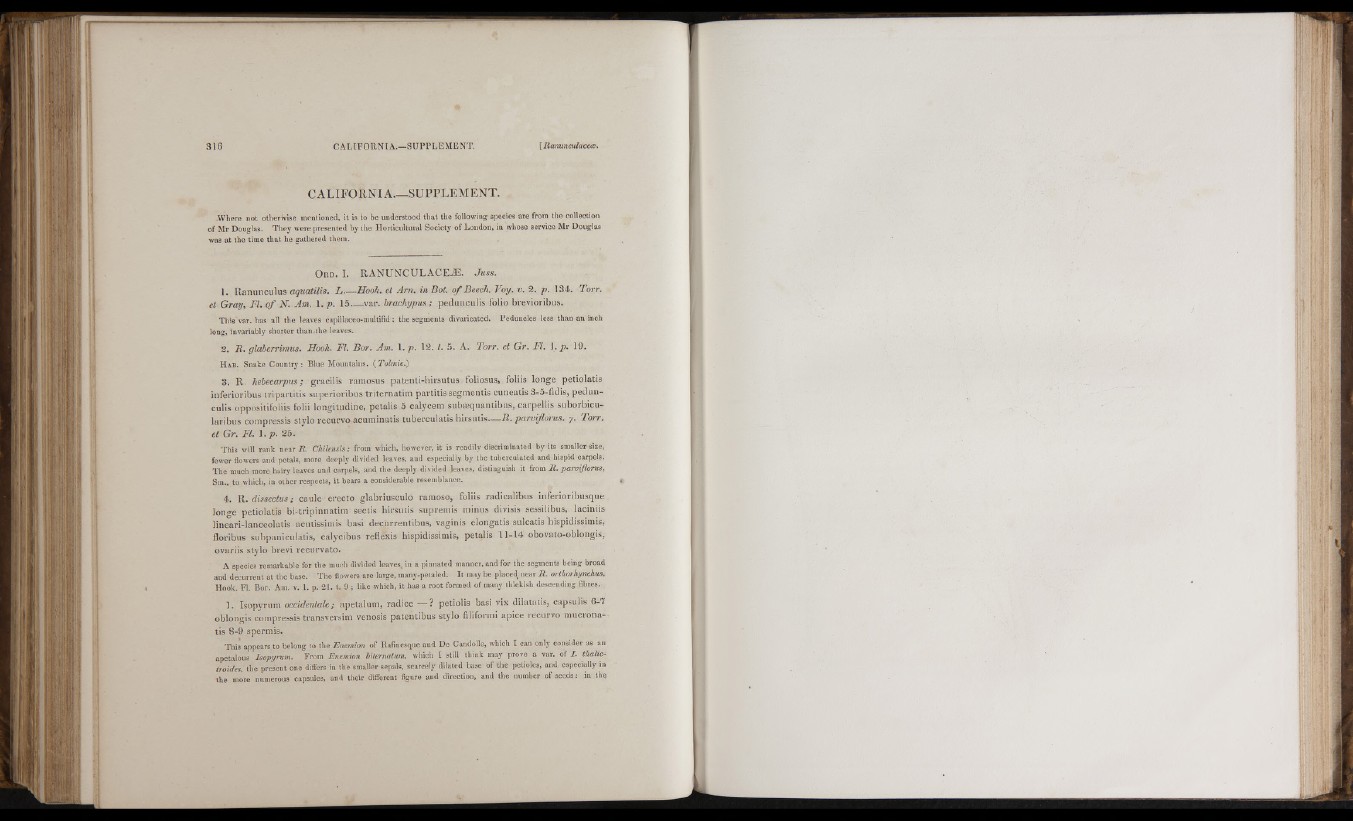
i r l i ’
) Vi
!/ï
CALIFORNIA— SUPPLEMENT.
Where not otherwise montioned, it is to be understood that the following species are from the collection
of Mr Douglas. They were presented by the Horticultural Society of Loudon, in whose service Mr Douglas
was at the time that he gathered them.
O r d . I. R A N U N C U L A C EÆ . Juss.
). Ranu n cu lu s aguatilis. L Hook, et Arn. in Bot. of Beech. Voy. v. 2. p. 134. Torr.
et Gray, I'L of N. Am. i.p . 15 var. brachypus ; pedunculis folio brevioribus.
This var. has all the leaves capillaceo-multifid : the segments divaricated. Peduncles less than an inch
long, invariably shorter than the leaves.
2. R . glaberrimus. Hook. FL Bor. Am. 1. p. 13. t . 5. A. Torr. et Gr. FL 1. p. 19,
Hab. Snake Country: Blue Mountains. {Tolmie.')
3. R. hebecarpus; gracilis ramosus paten ti-h irsu tu s foliosus, foliis longe petiolatis
inferioribus trip a rtitis superioribus trite rn atim p artitis segmentis cuneatis 3-5-fidis, p ed u n culis
oppositifoliis folii longitudine, petalis 5 calycem subæquantibus, carpellis suborbicu-
laribus compressis stylo recurvo acuminatis tuberculatis h irsutis— R. parviflorus. y. Torr.
et Gr. FL \.p .2 ò .
This will rank near R . Chilensis; from which, however, it is readily discriminated by its smaller size,
fewer flowers and petals, more deeply divided leaves, and especially by the tuberculated and hispid carpels.
The much more hairy leaves and carpels, and the deeply divided leaves, distinguish it from R . parvifloi-us,
Sm., to which, in oilier respects, it bears a considerable resemblance.
4. R. d'lssectus ; caule e recto glabriusculo ramoso, foiiis radicalibus inferioribusque
longe petiolatis b i-tripinnatim sectis hirsutis supremis minus divisis sessilibus, laciniis
lineari-lanceolatis acntissimis basi decurrentibus, vaginis elongatis sulcatis liispidissimis,
floribus subpaniculatis, calycibus reflexis hispidissimis, petalis 11-14 obovato-oblongis,
ovariis stylo brevi recurvalo.
A species remarkable for the much divided leaves, in a pinnated manner, and for the segments being broad
and decurrenl at the base. The flowers are large, many-pelaled. It may be placed near R . orthorhynchxis.
Hook. Fl. Bor. Am. v. 1. p. 21. t. 9 ; like which, it has a root formed of many thiekish descending fibres.
1. Isopyrum occidentale; apetalum, radice — ? petiolis basi vix dilatatis, capsulis 6-7
oblongis compressis transversim venosis patentibus stylo filiformi apice recurvo mucronatis
8-9 spermis.
This appears to belong to the Enemion of Rafinesque and De Candolle, tvhicli I can only consider as an
apetaious Isopyrum. From Enemion biternatum, which I still think may prove a var. of I. ihalic-
troides the present one differs in the smaller sepals, scarcely dilated base of the petioles, and especially in
the more numerous capsules, and tl.eir different figure aud ditecliou, and the nuinbet of seeds : in tlie